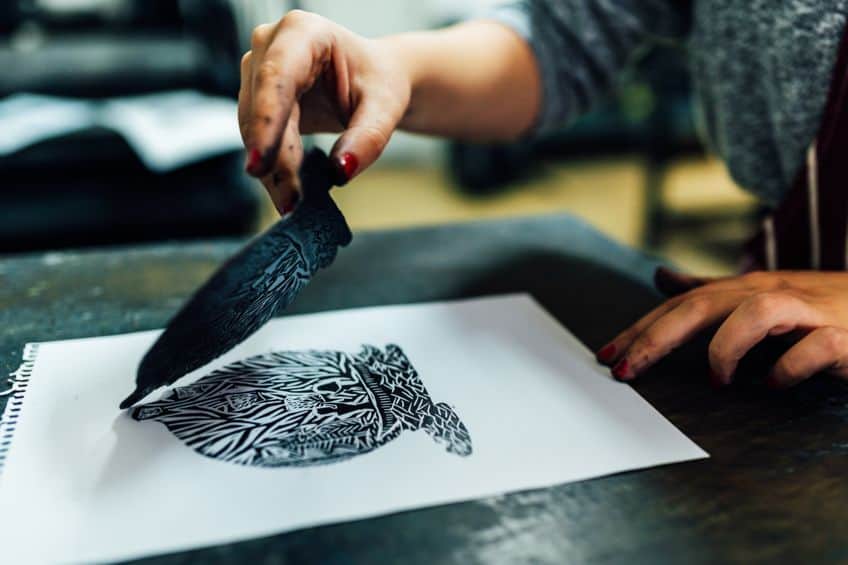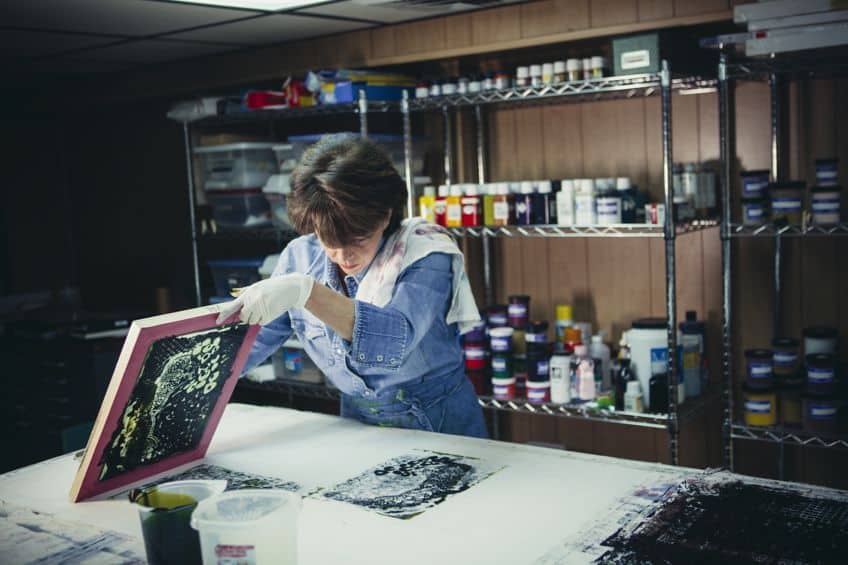Monoprinting – Learn the Art of Monoprinting Techniques
Printing is a massive genre of art, with numerous subdivisions of styles and techniques within. Lithography, digital printing, and screen printing are only three examples of the many techniques one could use to create a print. The topic of this article concerns a style of printmaking called monoprinting. If you are interested in learning more about this art form, you have come to the right place. Join us as we discuss monoprinting, its various styles, and how to do it yourself!
Contents
What Is a Monoprint?
Monoprinting can be described as a form of printmaking that gives artists the ability to produce unique, one-of-a-kind prints. Most traditional forms of printmaking techniques involve the production of numerous identical copies of a single design, the approach to printmaking offered by monoprinting is more fluid and spontaneous. To put it very simply, a monoprint is a print created by the transfer of ink or paint from a flat surface, such as a metal or glass plate, onto a sheet of paper or an otherwise suitable substrate. The reason why we call it “monoprinting” is that each print produced in this fashion cannot be replicated exactly as it is. This remains the case even if the same plate and surface are used again.
What makes monoprinting dissimilar from most other printing techniques is the fact that the image is only technically produced once. This means that you would expect to find a lot of unique pieces of art when it comes to monoprinting. There are other techniques to exploit as well to give a monoprint some more character, such as incorporating painting, drawing, and printing. You have the option to use other styles of printing to produce multiple prints, but a monoprint itself is only made once.
You can always use the same monoprint to create a series of the same images. What makes this easier is to design a simple matrix pattern. For this, you could use something like a stamp or copper etching, which you could use multiple times. However, the surface will be inked differently every time. An easy way to add any additional unique elements is through painting directly onto the print, and so forth.
Monoprinting is, however, meant to be a style of art wherein a singular print is made.
This is typically performed on non-porous and smooth surfaces. This is meant to be a once-off procedure, but styles such as ghost printing involve multiple uses of the monoprint. One thing to understand is that monoprinting and monotypes are not the same things. Monoprinting can typically feature a series of patterns or images printed more than once. Monotypes, on the other hand, are unique and should not contain any elements that have already been used before.
History of Monoprinting
Elements drawn from drawing and painting are infused to create monoprinting, and the art form’s history is rather murky in terms of when it first started. Nevertheless, we are well aware of some famous monoprinting artists who have lived throughout the centuries. In the 17th century, for example, there was a famous Dutch painter named Hercules Seghers who is believed by many art historians to be the one who popularized monoprinting. Linework with various shades of ink, paper dyeing, and landscapes were popular features in his artworks.
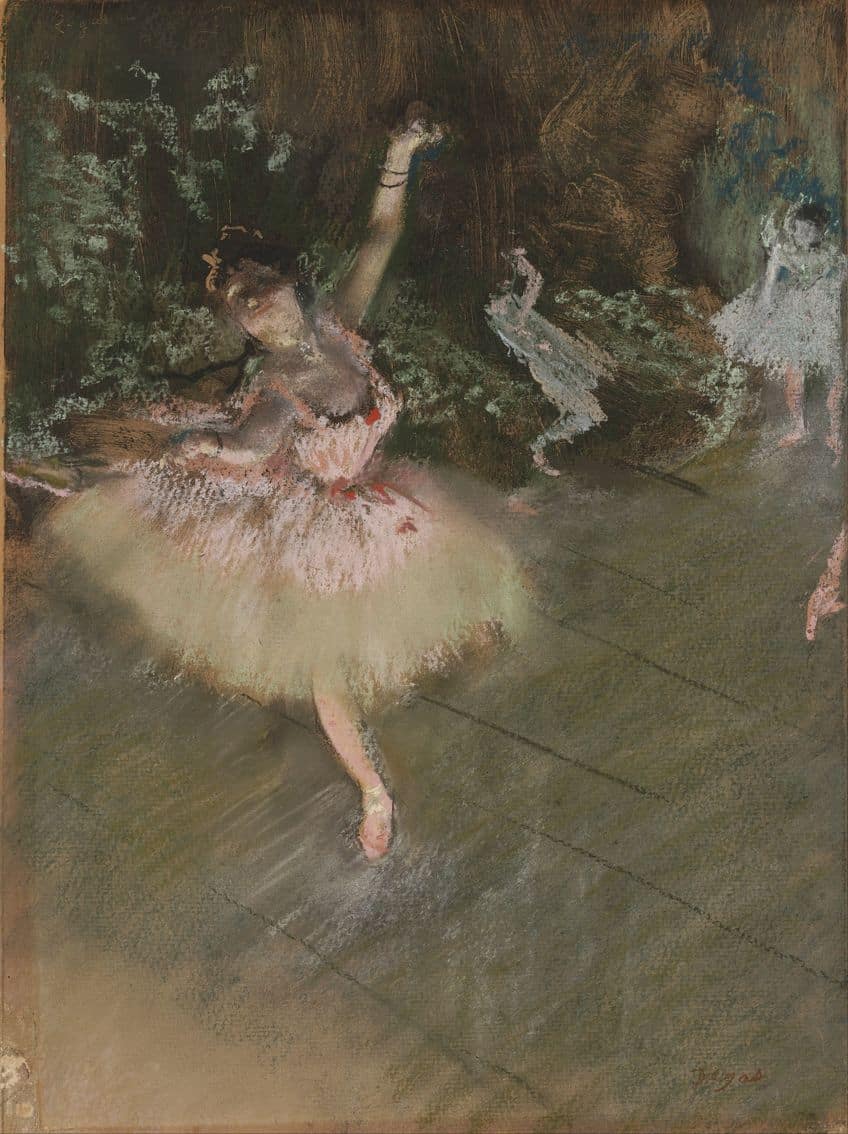
Edgar Degas, another famous painter, would once again popularize the technique of monoprinting in the 19th century. His monotype prints were characterized by the use of rags, different paints, and even his own fingers. Heads of a Man and a Women (1877-1880) is a popular example of his monoprinting artwork style. Degas was also known for his use of multiple types of media in his monoprinting. His monotype titled The Star (1876-1877) involved the use of pastels.
A Danish-French artist by the name of Camille Pissarro would later take inspiration from Degas and start to produce his very own type of monotype artwork.
Soon thereafter, the artist Paul Gauguin would invent the style of monoprinting called trace monotype. Multiple sheets of paper were drawn on in this technique. One sheet of paper would have printing ink rolled out on it, after which a second sheet would be applied over it and then drawn on. The Two Marquesans (1902) and The Pony (1902) are counted among his best works in monoprinting, the latter of which was printed using gouache.
Monoprinting Techniques
Monoprints can be produced using a plate or block made from wood or metal onto which the etchings are made. You are then typically able to use the tool to produce a single impression, which can later be painted on or used to create a collage. Most typically, however, the primary method used in monoprinting is inking etching plates. You can also experiment with your choice of colors, pressure, and techniques to create different styles of monoprints. If you are interested in monoprinting, there are numerous techniques to choose from. Better yet, each comes with its own characteristics and endless possibilities. Here are some of the most popular techniques used in monoprinting.
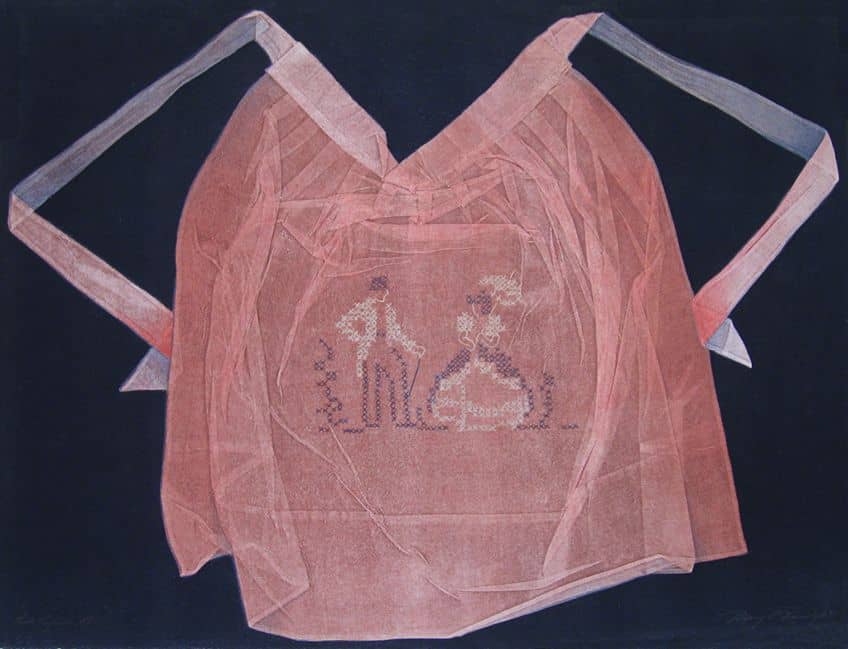
Gelli Plates
You can also use gelatin plates for monoprinting. On account of their reusability, ease of use, and durability, they actually make for a good choice of tool to apply the design onto substrates such as fabric and paper. You could also incorporate the use of different materials and tools to produce more complex designs.
Monoprint Masking
This is achieved by laying a flat shape in between your paper and inking surfaces. Whatever item you are inking can be inked in numerous colors in order to produce a contrast. Otherwise, it can be left unpainted in some parts that would then remain blank when printed onto a material. The items you use can vary in size and shape, depending on the measurements of your canvas. The materials we would encourage you to experiment with are simple things like trash bags or leaves – basically, anything easy to find anywhere that produces an interesting texture.
Areas of a monoprint can be masked to leave space clear for the addition of handwritten text after the print has dried.
Reductive Monoprinting
Another common technique is known as “reductive monoprinting,” which involves monoprinting artists selectively removing ink from a plate or surface to create an image. This can be done using a variety of tools and materials, including brushes, rags, and even Q-tips. By carefully removing ink in strategic areas, artists can create a wide range of textures and patterns, as well as intricate and detailed images.
Monoprint Collage
In these monoprinting techniques, ink is not the only medium that will be applied to your substrate. Before the blank substrate is printed, flat items and images will first be adhered to the surface. Once these additional items have been pinned to the substrate, you would then proceed with placing the image down and inking the surface. You would then be left with an interest in multimedia monoprints. With enough practice, you can get very creative with this technique. You can also use monoprints as an element in the general art style of collaging, where it can be accompanied by a variety of other mediums.
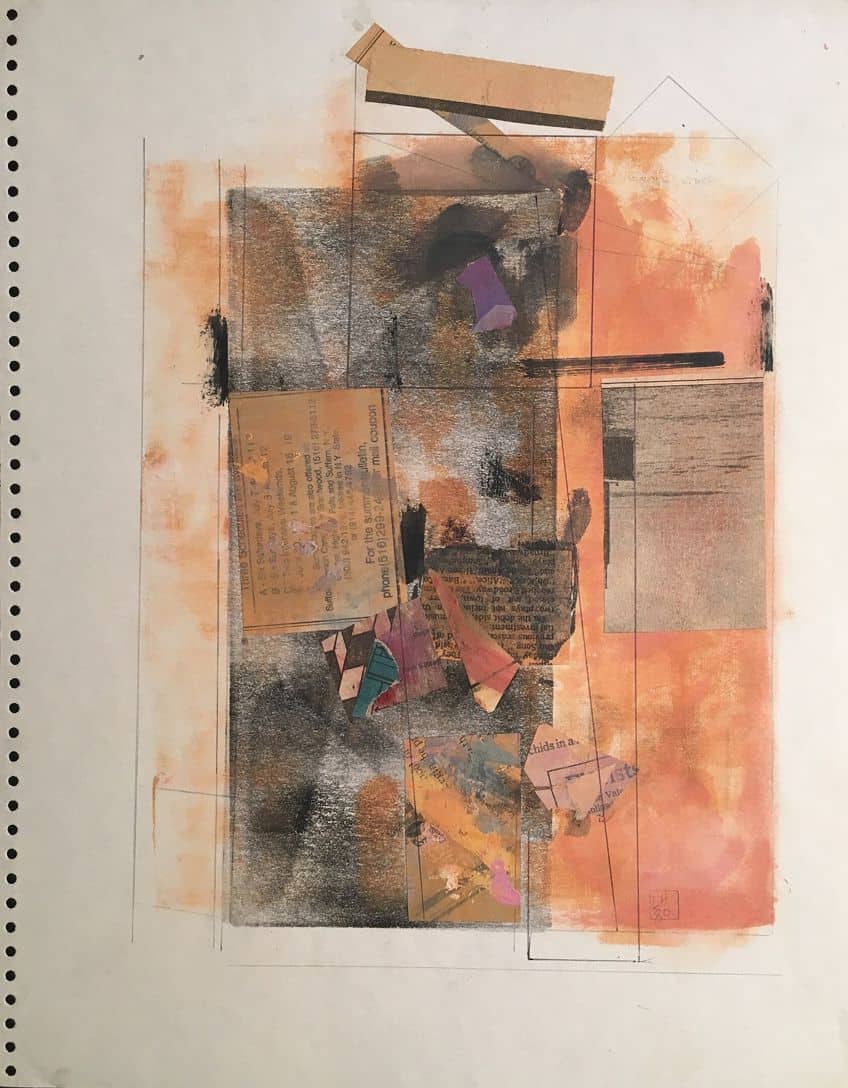
Ghost Printing
Ghost printing is one of the more popular styles of monoprinting, and it involves printing an image onto a sheet of paper and then using the ink residue left on the plate to create a second print with more subtle details. One would rinse and repeat this process several times to create a series of prints that slowly become more abstract and lighter with every subsequent frame.
Dendrite Fractals
If you are looking for simple monoprint ideas, this one might appeal to you as they are easy to do yet produce visually stunning results. You could acquire two sheets of the same paper or canvas to produce dendrite fractals, which are fun and easy-to-make artistic flairs that can be produced in a variety of ways. To make them using monoprinting, you can begin by adding shapes, dots, and lines of ink onto one sheet. Do not roll the ink on. Instead, dab it on in blotches. Before carrying on, you should consider using more than one color to create an interesting effect.
You may then place the unpainted sheet over the painted one and begin to press down. Make sure that you apply pressure so that enough compression is achieved between the sheets, which can then be pulled apart to reveal the stunning effects.
Monoprinting Watercolors
If you do not have access to ink or wish to work with a safer medium, you could use watercolor paints instead. If you do it just right you will not even be able to tell the difference. For starters, you will need to acquire a surface that is transparent, such as glass. Next, acquire an image that you would like to duplicate and then secure it under your transparent surface using painter’s tape. The next thing to do is trace your image using watercolors that you apply directly to the transparent surface. Before moving on, you should give the paint time to completely dry first. Then you can slightly dampen some watercolor paper before placing it above the surface you have just painted. Leave it sitting for a while before lifting it to reveal your completed watercolor print.
Tracing Method
Using a method not so different from the technique that Paul Gauguin created, you could start by tracing an image. For the sake of simplicity, you could capture something as simple as the outline of a photo or portrait. Then you can make sure they apply an even layer of ink to your surface, taking care to lay paper on top where it will be secured using tape. The image being traced must then be positioned facing up above the paper. Using a dull pencil tip, you can gently trace over the image. Once done, you may lift the photo from the paper to reveal the image you have outlined.
Tabletop Monoprinting
If you do not mind getting a little bit messy if it means good fun, tabletop monoprinting is probably one of the best monoprinting ideas for you to consider. For starters, you must tape out the measurements of a rectangle that is the exact same size as the paper you will be printing on. Inside this rectangle, you should use the same tape to create a tinier rectangle. The ink must be spread within this smaller rectangle. Before printing, the smaller rectangle must be taken away as this will give the printed image a sharper and cleaner edge. You can also use a variety of brushes, pens, and other tools to create different styles of detail in the ink.
Typically, you should achieve a more aesthetically pleasing print if you use a wider array of marking tools. Once you have completed your image, you can remove the smaller rectangle. You can then place some paper over the ink where it must be lightly burnished.
Plexiglass and Transparency Prints
The surfaces of plexiglass sheets can actually be inked, which makes them suitable substrates for monoprinting. Using items such as leaves or doilies, texture can even be added to the print. You could also experiment with different palettes of paint to make the design pop out. To make a transparency print, you will have to roll the paper over the inked surface using a brayer. Alternatively, you could use something like a transparency sheet to apply the ink to and then later manually sketch the lines and shapes before laying the paper onto the ink.
Benefits of Monoprinting
One of the primary advantages of monoprinting is the degree of control that is on offer to artists who work with this medium. Unlike most other forms of printmaking, which often require meticulous planning and precision to execute correctly, monoprinting allows for a more improvisational approach. Once a bit of experience is gathered, artists can experiment with different colors, textures, and techniques, responding to the unique properties of each print as it develops. Since each monoprint can be unique, collectors and art enthusiasts often place a lot of value on artworks such as this. What this has spawned is a vibrant and diverse community of artists working in the medium, each exploring the possibilities of monoprinting in their own interesting way.

Despite its comparative simplicity, monoprinting can at some points prove challenging but rewarding working in this medium can also be incredibly rewarding. It does require a certain level of technical skill, which will develop naturally over time. But it also demands a willingness to experiment and take risks. For artists who are willing to put in the time and effort, the results can be truly stunning.
In addition to the artistic potential within the medium, monoprinting is also a great avenue through which artists are able to experiment with different techniques and approaches to printmaking in general. By working with the medium of monoprinting, artists can develop their skills and explore new possibilities, which will ultimately end up expanding their creative horizons and pushing the boundaries of their art.
All in all, monoprinting is a dynamic and exciting form of printmaking that offers you a wealth of creative possibilities. Whether you are a seasoned printmaker or a beginner looking to explore a new medium, the chance is absolute that monoprinting has something unique and valuable to offer you.
Monoprinting Step-by-Step
Now that we know the answer to “What is a monoprint?” and have covered some of the many techniques applied in the art of monoprinting, we can discuss how to perform the task itself. Even though there is a wide variety of styles it can be done in, they mainly follow one key methodology, which will describe to you here. Just make sure that whichever surface you will be applying your ink to is smooth and not porous, be it plexiglass or any other suitable material. It should also be cleaned and dried before use.
When it comes to making the design, tracing it from any pre-existing subject matter is always an easy way to go about it. If you have never done monoprinting before, consider trying to keep your design simple or tracing it out. You should develop your skills before taking on more ambitious projects. You can incorporate the use of texture tools to add complexity to your designs as well. The following monoprint step-by-step guide can be used to navigate you through your first monoprinting experience.
- Use a brayer to apply a layer of ink to the surface of your sheet or palette. Make sure to use a conservative amount of ink and ensure that it is applied to the surface evenly.
- You can then create the design using texture tools or other techniques. This is what we call the subtractive method of monoprinting, which just so happens to be the easiest.
- You can then incorporate any additive techniques. These methods include masking and tracing.
- Make sure that the surface you are placing your ink on is either smaller or the same size as your paper. Doing so will reduce the amount of mess you have to clean up afterward.
- Pull the paper away from the inked surface with care to reveal your final print. Your print needs to be left on to completely dry.
- Lastly, make sure to clean your tools after they have been used. This will ensure that they last longer.
You should now know a little bit more about monoprinting, its history and various styles, and how to do it yourself. Monoprinting is an art form that takes some getting used to, but the process is addictive and the results can be beyond stunning. Do not be discouraged if your first attempt does not pan out the way you wanted. Monoprinting is inexpensive and thus easy to replicate after a bad job, and you will only get better the more you practice. This can make a great activity for people of all ages and the barrier to entry is quite low. We hope that we have inspired you to give monoprinting a try, as it is such a fun medium with endless possibilities within.
Frequently Asked Questions
What Is Ghost Printing?
This is one of the most popular techniques applied in monoprinting art. It involves the printing of an image onto a sheet of paper and then using the residual ink on the plate to create another print, wherein the details appear more subtle. The process can be repeated several times until a series of images are produced that, if placed side by side, would showcase a gradient of the same image becoming more abstract and lighter with every passing frame.
What Is a Monoprint?
To put it most simply, a monoprint is a print created by transferring ink or paint from a flat surface, such as a metal or glass plate, onto a sheet of paper or an otherwise suitable substrate. The reason why it is called monoprinting is that each print produced in this fashion cannot be replicated exactly as it is. This remains the case even if the same plate and surface are used again.
What Is the Best Ink for Monoprinting?
Water-based inks work best for monoprinting, hence why they are the most commonly used medium in this art style. Water-based ink is favored for the fast drying times that make it suitable for the production of simple prints. Block printing is another medium that could be explored if you do not want to use inks that are oil-based. You do not need fancy paper for monoprinting, as even standard cartridge paper will suffice.
What Materials Are Used in Monoprinting?
Besides the ink, which should be water-based if you are a beginner, you will need a non-porous surface that is smooth to spread your ink on. Brayers are also super useful. You can also get your hands on some paper or another suitable canvas, old clothes for cleaning, and any drawing instruments you may need. Keep in mind that you do not have to always use ink, as other mediums such as watercolors work just fine as well.
Liam Davis is an experienced art historian with demonstrated experience in the industry. After graduating from the Academy of Art History with a bachelor’s degree, Liam worked for many years as a copywriter for various art magazines and online art galleries. He also worked as an art curator for an art gallery in Illinois before working now as editor-in-chief for artfilemagazine.com. Liam’s passion is, aside from sculptures from the Roman and Greek periods, cave paintings, and neolithic art.
Learn more about Liam Davis and about us.
Cite this Article
Liam, Davis, “Monoprinting – Learn the Art of Monoprinting Techniques.” artfilemagazine – Your Online Art Source. May 22, 2023. URL: https://artfilemagazine.com/monoprinting/
Davis, L. (2023, 22 May). Monoprinting – Learn the Art of Monoprinting Techniques. artfilemagazine – Your Online Art Source. https://artfilemagazine.com/monoprinting/
Davis, Liam. “Monoprinting – Learn the Art of Monoprinting Techniques.” artfilemagazine – Your Online Art Source, May 22, 2023. https://artfilemagazine.com/monoprinting/.


